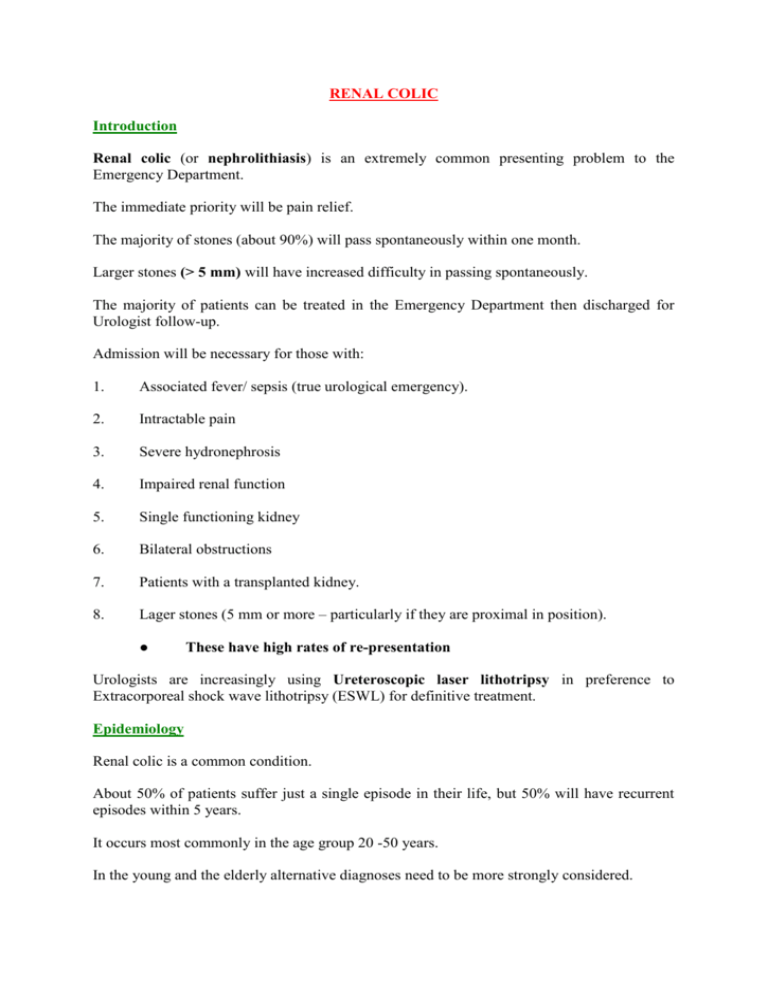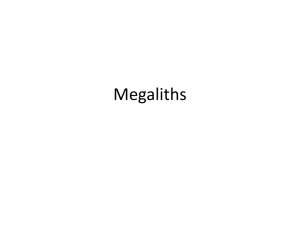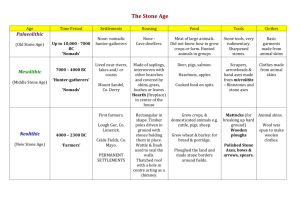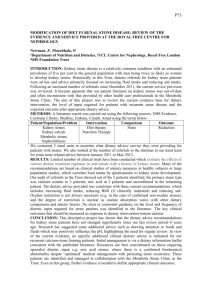Renal Colic - EDventures
advertisement

RENAL COLIC Introduction Renal colic (or nephrolithiasis) is an extremely common presenting problem to the Emergency Department. The immediate priority will be pain relief. The majority of stones (about 90%) will pass spontaneously within one month. Larger stones (> 5 mm) will have increased difficulty in passing spontaneously. The majority of patients can be treated in the Emergency Department then discharged for Urologist follow-up. Admission will be necessary for those with: 1. Associated fever/ sepsis (true urological emergency). 2. Intractable pain 3. Severe hydronephrosis 4. Impaired renal function 5. Single functioning kidney 6. Bilateral obstructions 7. Patients with a transplanted kidney. 8. Lager stones (5 mm or more – particularly if they are proximal in position). ● These have high rates of re-presentation Urologists are increasingly using Ureteroscopic laser lithotripsy in preference to Extracorporeal shock wave lithotripsy (ESWL) for definitive treatment. Epidemiology Renal colic is a common condition. About 50% of patients suffer just a single episode in their life, but 50% will have recurrent episodes within 5 years. It occurs most commonly in the age group 20 -50 years. In the young and the elderly alternative diagnoses need to be more strongly considered. Pathophysiology Low fluid intake, with a subsequent low volume of urine production, predisposes to high concentrations of stone-forming solutes in the urine, and so dehydration is thought to be a factor in the formation of renal tract stones. Hereditary factors are also thought to be involved. Stone types: 1. Calcium based, (75%): States of hypercalcemia (from any cause) may predispose to calcium stones. These may take the form of: 2. ● Calcium oxalate ● Calcium phosphate ● Calcium oxalate/ phosphate mix. Uric acid stones (8%): ● These stones are associated with a urinary pH of less than 5.5, high dietary purine intake or malignancy (i.e., rapid cell turnover). Approximately 25% of patients with uric acid stones will also have gout. 3. Struvite (magnesium ammonium phosphate) stones (15%): ● These are thought to be associated with chronic urinary tract infection with gram-negative bacilli that are capable of splitting urea into ammonium, which can then combine with phosphate and magnesium. Usual organisms include Proteus, Pseudomonas, and Klebsiella species. Escherichia coli is not capable of splitting urea and, is therefore not associated with struvite stones. Urine pH is typically greater than 7.0 4. Cystine based (2%) ● 5. They are caused by a metabolic defect resulting in failure of renal tubular reabsorption of cystine, ornithine, lysine, and arginine. Urine becomes supersaturated with cystine, with resultant crystal deposition. Xanthine stones (rare): ● These are caused by an inborn defect of the enzyme xanthine oxidase. Complications: The most important include: 1. Infection: ● 2. This is a true Urological emergency in the setting of an obstructed renal tract. Severe hydronephrosis, leading to longer term cortical atrophy. When severe hydronephrosis is present rupture can occur with the formation of a “uroma” Common sites of stone obstruction include: ● Pelviureteric junction (PUJ) ● Pelvic brim, (as the ureter crosses in front of the iliac artery). ● Vesicoureteric junction (VUJ) Clinical Assessment Important points of history: 1. Nausea and vomiting are common. 2. Pain is usually severe and colicky in nature, with loin pain radiating to the groin, testes/labia 3. If pain is constant and prolonged, this may indicate: ● Complicating pyelonephritis. ● Total obstruction with severe hydronephrosis ● Pelvic calyceal rupture with uroma 4. Pain confined to the RIF/ LIF may indicate a stone in the region of the VUJ. 5. Suprapubic pain may indicate a bladder stone 6. Is the patient on warfarin or a NOAC? ● Clot retention and retroperitoneal hematoma need to be considered as a differential diagnosis. Important points of examination: 1. Vital signs: Fever in particular: ● 2. This will indicate the serious complication of obstructive pyelonephritis. The patient is usually in significant distress and is unable to remain still. ● If the patient remains still and is reluctant to move, this is more suggestive of “peritonism” and pyelonephritis. 3. It is important to check for testicular tenderness/swelling/ inflammation (as testicular pain may radiate towards the groin and thus “mimic” renal colic). 4. Hematuria: ● This can be microscopic or macroscopic. Differential Diagnosis: The clinical diagnosis of renal colic is usually straight forward. Important differential diagnoses, however include: 1. Expanding or ruptured abdominal aortic aneurysms in the elderly. ● In fact renal colic is relatively uncommon in the elderly and abdominal aortic aneurysms must always be considered in any elderly patient presenting with back or loin pain. 2. Lower lobe lung pathology, such as pneumonia or pulmonary embolism. 3. Bleeding conditions: ● Retroperitoneal hematoma, (especially if the patient is on warfarin) ● Clot within the renal tract. 4. PUJ obstruction may result in pain similar to renal colic. 5. Testicular pathology. 6. Drug seeking behavior: Investigations Blood tests: 1 FBE: ● 2. WCC may be mildly elevated, however a count above 15000/ mm3 suggests complicating infection. CRP ● If complicating infection is suspected. 3 U&Es and glucose 4. Beta HCG in women of child bearing age, should always be considered. The following should be done for first episodes of renal colic, (or if not previously done): 4. Calcium phosphate. 5. Uric acid level FWT: Most cases will show positive for blood, however, its absence does not rule out renal colic. The incidence of hematuria increases with the acuity of the attack.1 ● Acute renal colic requiring opioids has an incidence of hematuria of 90 %. ● Subsiding colic has an incidence of hematuria of 85 %. ● Post colic (pain resolved) has an incidence of hematuria of 80 % ● Quiescent calculus has an incidence of hematuria of 50 % Stone analysis: If a stone or “gravel” is seen in the urine, it can be sent to the pathology laboratory for analysis. KUB: This is a plain abdominal x-ray that is focused on the region of the kidney, ureter and bladder, (hence “KUB”). It need only be done if the CT scan is positive for a renal stone. The majority of stone are radio opaque, however KUB alone is not sufficient to diagnose nephrolithiasis as it has poor sensitivity (around 60% only). It is primarily used to document the position of the stone for future follow-up by the urologist. It is also done to assess whether the stone is radiolucent on plain radiographs or not for subsequent follow up purposes. ● It is useful to have a plain x-ray to document that the stone is opaque - that way at follow up the Urologist only needs to do another plain x-ray to chart progress of the stone and so the patient can be spared having a repeat CT KUB. ● If the stone is not seen on a plain KUB, however then it is radiolucent - and so at follow-up a CT KUB will need to be done to assess progress. (because CT can pick a lucent stone whereas plain x-ray may not) up Note that 100% of stones are seen on CT, whilst only 85% of stones are seen on plain x-ray. Whether a stone is seen on plain x-ray largely depends on its composition. CT KUB: Virtually all renal stones are visible on CT (without contrast). CT scan is the investigation of choice. It is far less time consuming than IVP (traditionally performed in the past) and does not expose the patient to the risk of IV contrast and there is no requirement for bowel preps. It is better able to visualize smaller stones and most importantly it has the ability pick up other unsuspected conditions such as aneurysms and diverticulitis. CT may also distinguish complicating pyelonephritis and uroma from simple hydronephrosis. As well as visualizing a stone CT is also valuable for assessing the degree of associated hydronephrosis: Hydronephrosis refers to distension of the renal pelvis and calyces, caused by an obstructive uropathy. Untreated, it leads to progressive atrophy of the kidney. Hydroureter is defined as a dilation of the ureter. Hydronephrosis is generally classified by radiologists somewhat arbitrarily as mild, moderate or severe. By some definitions this has been defined as: Mild: ● Hydronephrosis as enlargement of the calices with preservation of the renal papillae. Moderate: ● Hydronephrosis as rounding of the calices with obliteration of the renal papillae. Severe: ● Hydronephrosis as caylaceal ballooning, (if there is also cortical thinning then the obstruction is chronic). Patients should ideally have their CT scan before leaving the Department to ensure diagnosis is made and to help rule out other unsuspected conditions. Ultrasound: Ultrasound is a useful screening test for the detection of hydronephrosis; however it cannot reliably detect renal stones. It is a useful screening test in particular for patients in whom radiation is best avoided. MRI: This can be an option for stone detection in pregnant women, though it currently lacks sensitivity for smaller stones. Management 1. Analgesia: For suspected Renal Colic the immediate priority will be analgesia. Non-selective NSAIDs and opioids provide effective analgesia for renal colic. 2,6 For mild to moderate pain use: 6 ● Ibuprofen 400mg orally 6 hourly prn With or without: ● Oxycodone immediate release 5 to 10mg orally 4 to 6 hourly prn Note however that NSAIDS should be used with caution, if at all, in the elderly or in the presence of renal disease or peptic ulcer disease. Alternative options in those unable to tolerate oral medication include: ● 30 mg IM or IV ketorolac ● 100 mg PR indomethacin (if tolerated by the patient). For severe pain use: 6 Morphine: ● Morphine 2.5 to 5mg IV as an initial dose, then titrated to effect every 5 to 10 minutes with further incremental doses of 2.5 to 5mg IV ● In elderly patients or those with cardiorespiratory compromise, an initial morphine dose of less than 2.5mg IV and incremental doses of 0.5 to 1mg should be considered. ● Patients should be reassessed to determine if the dose has been effective or if there are any adverse effects (especially sedation). Fentanyl: ● If morphine is contraindicated, consider fentanyl at 25 to 50 micrograms IV as initial equivalent dose. Note that there is no good evidence that the use of IM buscopan reduces the requirement for narcotic analgesia in patients with renal colic. 3 2. IV fluids: Some authorities believe that intravenous fluids hasten passage of the stone through the urogenital system. Others express concern that additional hydrostatic pressure exacerbates the pain of renal colic. The situation is unresolved, however: ● IV fluids may be necessary in patients with prolonged stays in the ED who remain “nil orally” and especially if there has been vomiting and dehydration. ● Fluids may also be necessary in case of narcotic induced hypotension. 3. Tamsulosin: This is an alpha1 blocker that many urologists prescribe in order to reduce ureteric spasm, and hence assist in the passage of ureteric stones. There are substantial alpha1adrenergic receptors in the distal ureter and ureterovesical junction. Its rationale for use is that it may be of some benefit in larger 5-7 mm stones, especially at the VUJ or distal ureter. If there are no contraindications give 400mcgs daily, for up to one week. are 4 A recent British trial however found that Tamsulosin 400 μg (and nifedipine 30 mg) not effective at decreasing the need for further treatment to achieve stone clearance in weeks for patients with expectantly managed ureteric colic. 4. Intervention: For stones that do not pass spontaneously with conservative management or when complications arise necessitating urgent removal interventional options include: Extracorporeal shock wave lithotripsy (ESWL) This was the standard non-invasive therapy in the past, until Ureteroscopic laser therapy became available. It is ideally suited to smaller stones with the renal pelvis Shock wave lithotripsy is the least invasive method of eliminating stones, but also the least effective. Contraindications include: ● Pregnant patients ● Anticoagulated patients. ● Stones > 1.5 cm ● Multiple stones (a relative contraindication) Ureteroscopic laser lithotripsy: 7 Currently, most patients with ureteric stones that require intervention will have ureteroscopic laser lithotripsy. Laser lithotripsy has a stone free rate that is superior to ESWL The use of pulsed lasers to break up stones has been advocated for 15 years, but such lasers have only become commonly available in Australia in the past 10 years in the private health system, and even more recently in the public health system. Retrograde uretero pyeloscopic laser lithotripsy has gained increased popularity with the miniaturisation of flexible uretero renoscopes and the wider availability of lasers. Latest generation instruments enable surgeons to explore the entire collecting system and achieve stone clearance rates of around 95% with a single operation for stones up to 1 cm, and 88% for stones 1- 2 cm in the lower pole. The technique however requires a GA and has higher complication rates than ESWL. Contraindications include: ● Urinary sepsis ● General contraindications to general anaesthesia. Patients on antiplatelet/anticoagulant drugs can continue taking the drugs with little increased risk. Complications include: ● Hematuria ♥ Very common but only problematic in <1 % of patients ● Infection ● Postoperative pain ● Ureteric injury (rare, but potentially significant). Percutaneous nephrolithotripsy/ nephrolithotomy: These are now generally reserved for stones larger than 2 cm, and most commonly for staghorn calculi. It has considerably more risks than retrograde lithotripsy, particularly bleeding and sepsis. Patients may have delayed retrograde laser lithotripsy or SWL to “tidy up” small remaining fragments in calyces not accessible to the percutaneous approach. Open nephro- or pyelo-lithotomy: Although open surgery is performed rarely for stone disease nowadays, it remains an effective treatment for staghorn calculi with stone clearance rates of >80%. However, it comes at the cost of a week in hospital, considerable postoperative pain from a loin incision and a 6 week recovery before return to work for most occupations. Disposition Most commonly patients can be treated the ED over a period of hours. They may be sent home if there are no other criteria for admission, once symptoms have settled with oral analgesia and a Urology outpatient referral. Criteria for admission include: 1. Any patient with a fever (see also pyelonephritis document) 2. Patients with intractable pain: Intractable pain may be due to a large stone (> 5 mm), which will have difficulty in passing spontaneously or severe hydronephrosis or even a “uroma”(ruptured caylaceal system) In general terms: 4 Stone Size Likely outcome ≤ 4 mm 90 % will pass within a month 5- 7 mm 50 % will pass within a month ≥ 7 mm 5 % will pass within a month The overall passage rates for a stone within the ureter are: 3 Position within the Ureter Overall likelihood of passage Proximal ureteric stones 25% Mid ureteric stones 45% Distal ureteric stones 75% Hydronephrosis: ● Mild or moderate cases can still be discharged so long as there are no other complicating factors. Cases of severe hydronephrosis usually require admission. 4 Deteriorating renal function. 5 Patients with a single functioning kidney. 6. Patients with bilateral obstructions 7. Patients with a transplanted kidney. 8. Lager stones (5 mm or more – particularly if they are proximal in position). ● These have high rates of re-presentation If uncertain, always consult with the Urologist. Many patients with renal colic may be suitable for a Short Stay Unit admission, until their pain is controlled. Appendix 1 Left: Non-contrast coronal section showing typical appearance of a renal stone, 6 mm, at the left pelvi-ureteric junction, in a 47 year old male. Right: Seen in transverse section. Stones appear to have the same density as bone on CT scan. Appendix 2 The Double J Stent: The double J stent is a thin, hollow stent that is often placed inside the ureter during surgery to ensure drainage of urine from the kidney into the bladder. J shaped curls are present at both ends to hold the tube in place and prevent migration, hence the description “double J stent”. They allow the kidney(s) to drain urine by temporarily relieving any blockage, or to assist the kidney(s) in draining stone fragments freely into the bladder if definitive kidney stone surgery is carried out. Stents are used in temporary situations and must eventually be removed from the body, within 6 months – but most are removed well before this








